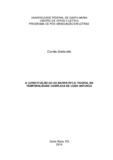| dc.creator | Stefanello, Camila | |
| dc.date.accessioned | 2017-11-23T10:57:34Z | |
| dc.date.available | 2017-11-23T10:57:34Z | |
| dc.date.issued | 2016-12-16 | |
| dc.identifier.uri | http://repositorio.ufsm.br/handle/1/12067 | |
| dc.description.abstract | “The constitution of the narrative and figural self in the complex temporality of Lobo Antunes” has as study object the novel What horses are those that make shade on the sea? (2009), by the contemporary Portuguese writer Antonio Lobo Antunes. In the novel it is narrated the story of the affective de-structure and the loss of the material goods of a traditional Portuguese family, through the voices of family‟s components. It is confused in the narrative, thus, the past experiences of the characters and their projections for the future. The characters-narrators, when remembering the past experiences and when projecting expectations for the future, defocus the present of the narrative in reflections that seem not to finish any conclusion about their experiences. It results from that a chaotic and bitter world, marked by multiple and contradicted affections of the characters in relation to their relatives, manifesting in the own structure of the narrative, with its ramifications, deviances and fragmentations. The configuration of the intrigue ends to evince, then, the conflicting and problematic nature of the own characters. This incessant returning to the past allied to this expectative of future and the reflections about the events reconstruct these distinct moments of experience of time in a present time always distended, in transition. The novel seems to reconstruct certain aporia of time, once that the time shows itself as makeable in the consciousness of the characters, and paradoxically, as fluid and transitory. This thick and complex character of temporality in the narrative configuration, the intertwine among told present, remembered past and expected future confers a psychological density to the characters, and never attributing to them an stable and cohesive identity and an integral image. We find, thus, in this dissertation, a reflection about the contemporary Portuguese literature, the work of the author, and an analysis of the novel based, mainly, on the studies of Paul Ricoeur about the interdependence among the configuration of intrigue, temporality and the constitution of a narrative identity. | eng |
| dc.description.sponsorship | Coordenação de Aperfeiçoamento de Pessoal de Nível Superior - CAPES | por |
| dc.language | por | por |
| dc.publisher | Universidade Federal de Santa Maria | por |
| dc.rights | Attribution-NonCommercial-NoDerivatives 4.0 International | * |
| dc.rights.uri | http://creativecommons.org/licenses/by-nc-nd/4.0/ | * |
| dc.subject | Lobo Antunes | por |
| dc.subject | Que cavalos são aqueles que fazem sombra no mar? | por |
| dc.subject | Temporalidade | por |
| dc.subject | Narratividade | por |
| dc.subject | Identidade narrativa | por |
| dc.subject | What horses are those that make shade on the sea? | eng |
| dc.subject | Temporality | eng |
| dc.subject | Narratives | eng |
| dc.subject | Narrative identity | eng |
| dc.title | A constituição do eu narrativo e figural na temporalidade complexa de Lobo Antunes | por |
| dc.title.alternative | The constitution of the narrative and figural self in the complex temporality of Lobo Antunes | eng |
| dc.type | Dissertação | por |
| dc.description.resumo | “A constituição do eu narrativo e figural na temporalidade complexa de Lobo Antunes” tem como objeto de estudo o romance Que cavalos são aqueles que fazem sombra no mar? (2009), do escritor português contemporâneo António Lobo Antunes. No romance, é narrada a história de desestruturação afetiva e de perda dos bens materiais de uma tradicional família portuguesa, através das vozes dos componentes dessa família. Confundem-se na narrativa, então, as vivências passadas das personagens e as suas projeções para o futuro. As personagens-narradoras, ao relembrar as experiências do passado e ao projetar expectativas para o futuro, desfocam o presente da narrativa em reflexões que parecem não encerrar conclusão alguma sobre suas vivências. Resulta disso um mundo caótico e amargo, marcado pelos múltiplos e contraditórios afetos das personagens em relação aos seus familiares, manifestado na própria estrutura da narrativa, com suas ramificações, desvios e fragmentações. A configuração da intriga acaba por evidenciar, então, o caráter conflitante, problemático das próprias personagens. Esse retorno incessante ao passado aliado a essa expectativa do futuro e às reflexões sobre os eventos reconstroem esses momentos distintos da experiência do tempo em um tempo presente sempre distendido, em transição. O romance parece reconstituir certa aporia do tempo, visto que os tempos mostram-se como marcantes na consciência das personagens e, paradoxalmente, como fluidos e transitórios. Esse caráter denso e complexo da temporalidade na configuração da narrativa, o entrelaçamento entre presente contado, passado relembrado e de um futuro esperado confere uma densidade psicológica às personagens, sem nunca atribuir-lhes uma identidade estável e coesa e uma imagem íntegra. Encontra-se nessa dissertação, uma reflexão sobre a literatura portuguesa contemporânea, a obra do autor, e uma análise do romance com base, principalmente, nos estudos de Paul Ricoeur sobre a interdependência entre a configuração da intriga, a temporalidade e a constituição de uma identidade narrativa. | por |
| dc.contributor.advisor1 | Oliveira, Raquel Trentin | |
| dc.contributor.advisor1Lattes | http://lattes.cnpq.br/8414562554311704 | por |
| dc.contributor.referee1 | Sparemberger, Alfeu | |
| dc.contributor.referee1Lattes | http://lattes.cnpq.br/9671613350365467 | por |
| dc.contributor.referee2 | Souto, Andrea do Roccio | |
| dc.contributor.referee2Lattes | http://lattes.cnpq.br/4763090579290391 | por |
| dc.creator.Lattes | http://lattes.cnpq.br/5466363192587665 | por |
| dc.publisher.country | Brasil | por |
| dc.publisher.department | Letras | por |
| dc.publisher.initials | UFSM | por |
| dc.publisher.program | Programa de Pós-Graduação em Letras | por |
| dc.subject.cnpq | CNPQ::LINGUISTICA, LETRAS E ARTES::LETRAS | por |
| dc.publisher.unidade | Centro de Artes e Letras | por |



